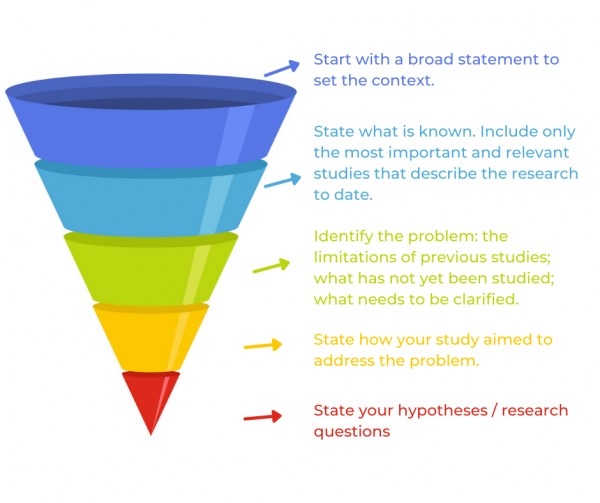




Quick Takeaways:
The English language has a rich history of borrowing words from other languages, especially from Latin. Latin abbreviations such as ‘a.m.’, ‘p.m.’ and ‘CV’ have become part of our everyday vocabulary. Such abbreviations are also frequently used in academic writing, from the ‘Ph.D.’ in the affiliation section to the ‘i.e.’, ‘e.g.’, ‘et al.’, and ‘QED’ in the rest of the paper.
This guide explains when and how to correctly use ‘et al.’ in a research paper.
在上一篇博文中,我們已經討論過如何運用IMRAD輔助記憶法協助撰寫論文摘要。我們這一篇博文將會集中在如何撰寫有效的引言。
在討論如何開始下筆前,我們要了解引言 (introduction) 在一篇論文中的目標及目的是什麼。
好的論文引言應該能讓讀者辨別得出你論文的研究主題、提供必不可少的內容,以及清楚表明你的研究的背後動機和焦點,而且更需要照顧到讀者的興趣和告知他們可在你的論文中讀到什麼。
總括而言,你可以在開始撰寫前問一下自己以下幾個問題:
了解到什麼資訊你需要在引言部分提及後,可以考慮運用以下三個組織論文引言結構的基本原則。
你可以把論文引言結構想像成漏斗結構,頂部最闊的部分代表最基本的資料,然後一步步收窄到你在研究中想討論的特定問題、研究的目的及理論等等。
下面圖中列舉出在論文引言漏斗不同位置需要談及的個別資訊。
以漏斗構造概述一般的論文引言結構

最關鍵的一點在於要確保你的讀者能夠很容易跟得上你的邏輯及論証,簡單點來說,就是為什麼你會選擇這研究題目及研究設計。
你可以參考以下幾個步驟來組織你的論文引言部分的資訊流。
第一步: 運用論文標題中的關鍵字在開首幾句句子內讓該論文所在的學科領域能被讀者清楚的識別出來,以抓住他們的注意力。
但要緊記不可重覆摘要的任何部分。
第二步: 以一個簡短而又平衡的相關文獻回顧來建立框架。
切記不要只膚淺形容過往的研究,相反,你要提供一個批判思考去定義你的研究項目的需要。
第三步: 盡可能列出你的研究目的,以及如有需要時可再舉出一個或多個假設理論,來為你的研究方向提出理據。
你亦需要強調你的研究所能帶出的潛在結果及貢獻,以及扼要提及你論文的其餘部分。
你要時刻緊記你想在哪發表你的論文,因為這樣可以助你了解你的讀者。
舉一個例子,如你的論文將會在一般大眾期刊發表,你要確保簡潔易明。相反的,如你的目標是在高度專業的期刊發表你的論文,你可能就不再需要多花篇幅解釋一些你的讀者已經知曉的用詞及理論。
而最實用的建議就是查閱你的目標期刊的發表指引以取得相關資訊。
想要確保在論文引言中能將所有需要的資訊有效組織起來其實並不簡單。明顯地,你不可能在引言中包括所有資訊,這亦帶出以下的問題:
作為粗略參考,引言應該大約是整篇論文的20%字數左右。但是,長度亦會因不同學科以及你計劃投稿的期刊的字數要求而有所不同。
固此,時刻查閱目標期刊的發表指引以及類似論文的引言長度以作參考。
如果沒有引言提供的方向及背景,你的讀者將會很易迷失及產生混淆,所以你要確保為他們提供需要的方向引導。
Wondering why some abbreviations such as ‘et al.’ and ‘e.g.’ use periods, whereas others such as CV and AD don’t? Periods are typically used if the abbreviations include lowercase or mixed-case letters. They’re usually not used with abbreviations containing only uppercase letters.
Our latest online workshop built on the success of face-to-face workshops we developed specifically for local universities. Over 30 faculty members joined the session, presented by our Chief Operating Officer, Mr Nick Case, to learn from our case studies on editing research proposals.
The response to our workshop, which included a constructive and insightful Q&A session, was very positive.Drawing on our extensive experience working with hundreds of Hong Kong researchers targeting the GRF and ECS every year, we used examples of poor and subsequently improved proposals to show the attendees how they can make their applications stand out. The response to our workshop, which included a constructive and insightful Q&A session, was very positive.Drawing on our extensive experience working with hundreds of Hong Kong researchers targeting the GRF and ECS every year, we used examples of poor and subsequently improved proposals to show the attendees how they can make their applications stand out. The response to our workshop, which included a constructive and insightful Q&A session, was very positive.Drawing on our extensive experience working with hundreds of Hong Kong researchers targeting the GRF and ECS every year, we used examples of poor and subsequently improved proposals to show the attendees how they can make their applications stand out.

Wondering why some abbreviations such as ‘et al.’ and ‘e.g.’ use periods, whereas others such as CV and AD don’t? Periods are typically used if the abbreviations include lowercase or mixed-case letters. They’re usually not used with abbreviations containing only uppercase letters.
Check out AsiaEdit’s professional research grant proposal editing service.
Read more about our training services covering all aspects of academic writing tailored for local institutions.
More resources on research grant proposal writing: On-demand Webinars
Preparing an effective research proposal – Your guide to successful funding application
Preparing an effective research proposal – Your guide to successful funding application (Part 2)

Rachel於2001年剛在 University of Exeter 取得博士學位的同時以自由編輯的身份首次加入我們。在擔任博士後研究人員數年之後,她專注於大學教授心理學,並於2010年回到AsiaEdit,並專注於學術編輯專業。她於2018年升任助理總編輯,並於2020年繼而成為我們的聯合主編。由於無法完全離開學術界,她還在意大利的一所英語大學教授心理學。
您的日程安排,我們最關切 AsiaEdit 採用個性化的編修方法。
香港灣仔軒尼斯道99號
彰顯大廈 2101室
上午 9:00 至下午 6:00
(+852) 2590 6588
